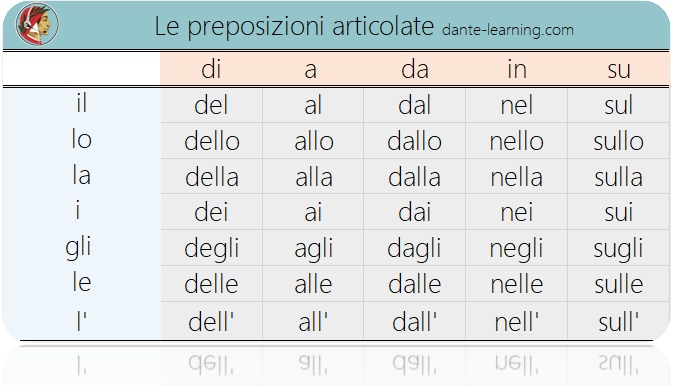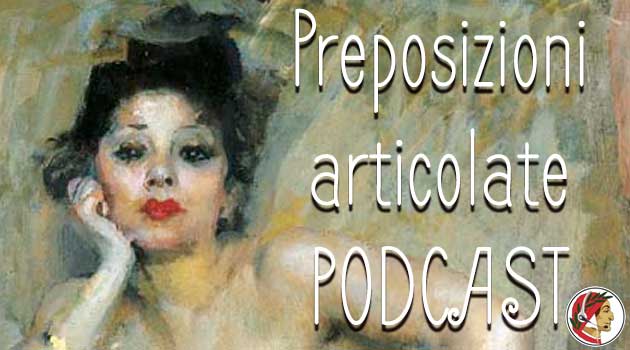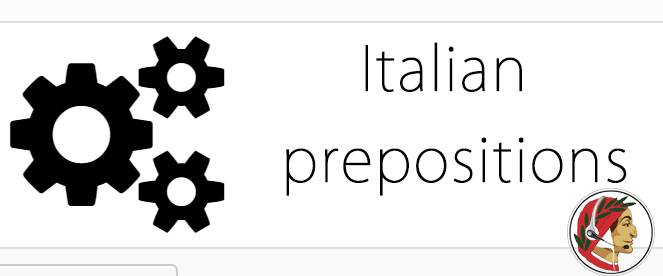Learn the Italian “preposizioni articolate”, compound prepositions, with examples and a free podcast.
Ciao a tutti.
Italians love to connect simple prepositions and articles for creating compound prepositions. The reason why compound prepositions exist is quite simple. They help different elements of a sentence to connect smoothly and keep a musical cadence when you speak or read. In fact, Italian wouldn’t be such a musical language without preposizioni articolate. Once you learn them, they will come out naturally and help you to speak more fluently. Ready to start?
Let’s take a very basic example, the classic “pen on the table”:
La penna è sul tavolo
=
La penna è su (+) il tavolo
Try to repeat the two sentences using SUL and the SU IL and compare the results. The first sentence is much smoother than the second.
Have a look at all the preposizioni articolate.

If you read carefully the overview of the preposizioni articolate, you will notice they all follow the same pattern.
A few notes before diving into some live language examples.
- We use only articoli determinativi (il, lo, la, i, gli, le, and l’ = THE) and not articoli indeterminativi (un, un,o una = A) for creating preposizioni articolate.
- Italian preposizioni semplici include per (for) tra and fra (between/among) but they don’t create any preposizioni articolate. So, for example we simply say: “Mi piace camminare tra la gente“
- Con is rapidly following the destiny of per tra and fra. Compound prepositions col and coi are used in the spoken language, less in writing. Con il and con i are more common.
- All the preposizioni articolate with di can be used as articoli partitivi, which indicate a part of uncountable nouns. e.g. Vorrei del latte ( I’d like some milk).
Ok, now we are ready. We’ll go through all of them with some examples
DI
-
DI + IL = DEL —> Il Milan è la mia squadra del cuore.
-
DI + LO = DELLO —> La macchina dello zio è una Alfa Romeo.
-
DI + LA = DELLA —> Stasera mangerò della pizza.
-
DI + I = DEI —> Giulia e Andrea sono amici dei miei figli.
-
DI + GLI =DEGLI —> Non è educato guardare nel piatto degli altri.
-
DI + LE = DELLE —> La mia favola preferita è “Alice nel paese delle meraviglie”.
A
-
A + IL = AL —> Domani mattina vado al mercato a fare la spesa.
-
A + LO = ALLO —> Il piatto di Milano è il risotto allo zafferano.
-
A + LA = ALLA —> Alla fine della cena di solito non bevo mai il caffè.
-
A + I = AI —> Venezia è cara, bisogna stare molto attenti ai prezzi.
-
A + GLI = AGLI —> Agli italiani piace tantissimo il calcio.
-
A + LE = ALLE —> Io e Laura abbiamo un appuntamento alle sette e mezza.
DA
-
DA + IL = DAL —> Mi fa male un dente, devo andare dal dentista.
-
DA + LO = DALLO —> Il satellite ha fotografato la terra dallo spazio.
-
DA + LA = DALLA —> Ho ricevuto un regalo dalla mia amica.
-
DA + I = DAI —> Mi piace quella ragazza dai capelli rossi.
-
DA + GLI =DAGLI—> Non accettare caramelle dagli sconosciuti.
-
DA + LE = DALLE —> Il supermercato è aperto dalle 7 alle 21.
IN
-
IN + IL = NEL —> Se hai sete, c’è della cola cola nel frigorifero.
-
IN + LO = NELLO —> Mario, metti la merenda nello zaino e vai a scuola.
-
IN + LA = NELLA —> Nella mia città ci sono due cinema.
-
IN + I = NEI —> Di solito nei giorni di sole faccio una passeggiata.
-
IN + GLI = NEGLI —> Negli Stati Uniti si parla inglese.
-
IN + LE = NELLE —> Nelle campagne toscane ci sono tanti vigneti.
SU
-
SU + IL = SUL —> Sono salito sul Duomo di Milano.
-
SU + LO = SULLO —> I tuoi libri sono sullo scaffale.
-
SU + LA = SULLA—> Il prossimo anno ci saranno nuove tasse sulla casa.
-
SU + I = SUI —> La foto del nuovo presidente è sui giornali di tutto il mondo.
-
SU + GLI =SUGLI —> In Amazzonia, le scimmie vivono sugli alberi.
-
SU + LE = SULLE—> Sulle spiagge italiane ci sono turisti da tutto il mondo.
Grazie e a presto!
Italian Painting of Today: Giuseppe Amisani, La modella (1920)



